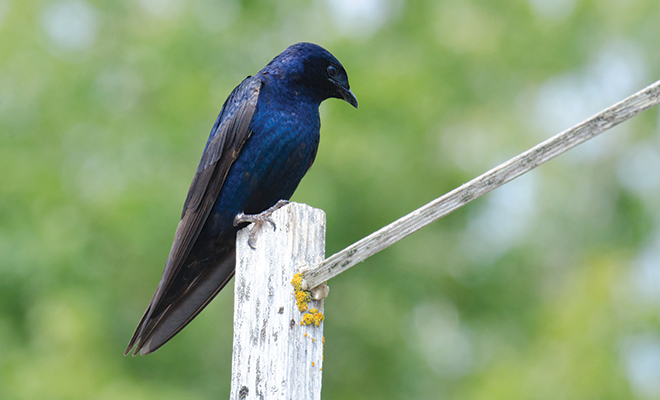
Purple Martins: Nature’s Insect Control
The purple martin is what you might call a people-loving kind of bird. For reasons that naturalists and scientists really can’t explain, this species of bird not only tolerates people but has become dependent on human-created birdhouses for nesting.
The relationship is a long one, with records found of early colonists and Native Americans building martin houses in the 1700s. Humans are so interested and invested in helping purple martins thanks to the species’ appetite for insect pests. They are also useful to farmers because they gang up on hawks, offering protection for barnyard birds.
The largest species in the swallow family, purple martins use existing holes for their nests. The species is found throughout the country, although in greatest numbers east of the Rocky Mountains. In the West, they are more likely to use abandoned woodpecker nests and natural cavities in trees for nests. In the East, they seek open areas near places where people live and will gravitate to birdhouses. In urban areas, purple martins will roost under bridges, in powerlines and in other human-made structures.
The diet of the purple martin consists of insects that they capture on the wing, including flies, beetles, wasps, bees, dragonflies and grasshoppers. Some folks may put up a birdhouse to harbor purple martins with the mistaken belief that they aid in mosquito control, a myth that can be traced in large part to an Illinois entrepreneur, J.L. Wade, who falsely proclaimed in the mid-20th century that a single purple martin could consume more than 2,000 mosquitoes per day to help promote sales of his aluminum birdhouses. At the time of his death in 2007, thousands of ornate birdhouses lined the streets of his small hometown, Griggsville, including a 40-foot tower containing more than 600 bird-sized apartments. His daughter told the Chicago Tribune that he was known as the P.T. Barnum of the bird world.
As far back as the 1960s, scientists debunked Wade’s claims about 2,000 mosquitoes per day by examining the stomach contents of purple martins. It was established then that these birds don’t eat a measurable amount of mosquitoes, but they do help control populations of larger insect pests. More recent research has found that purple martins feast on fire ants that have been introduced to the U.S. from South America, eating as many flying fire ant queens as they can find. This is an extremely helpful form of pest control, since fire ants have painful stings and may attack in a swarm when their ant hill is disturbed.
Some people enjoy having purple martins around for their activity and song as much as their pest control function. Writing in Heirloom Gardener, author Cindy Barlowe says, “Social birds, purple martins often engage human workers with song. Swooping low over my head, they frequently lure me close to the tall poles that hold their gourds and serenade with a lilting voice as long as I linger.”
Purple martins are so dependent on humans that many people feel protective toward them and there is a conservancy movement to attract them and provide homes. Besides aluminum, birdhouses can be made from a wide variety of materials, from hollowed-out gourds to plastic or wooden structures. Birdhouses for purple marlins are traditionally painted white or a light pastel color to reflect heat. Houses are typically raised 12 to 18 feet from the ground on a pole in groups of four or more since the birds nest in groups. There must be a way to lower the houses and check the nests. Purple martins have many natural predators, including hawks, owls, snakes and raccoons, so care must be taken to keep predators from attacking the birds in their nests. Locating birdhouse colonies in open areas away from trees can help prevent aerial attacks, and a protective guard at the bottom of each pole can guard against climbing predators.
North America is the nesting home of purple martins, but they migrate to South America in the winter. The majority of purple martins travel to the tropical rainforests of Brazil, but others find their way to Colombia, Venezuela and several other South American countries. Before they begin their migration, they leave their nests and gather in large groups to participate in migratory roosting, where thousands of purple martins will gather in a small area, often near a bridge or other human-made structure. After they rest up for their migration flight, they may cover as many as 5,000 miles over a six-week period. When they reach their destination, they roost in trees and around structures such as oil refineries.
You can find specifications for the size, shape and position of the birdhouse opening and other details on the website for the Purple Martin Conservancy. ■
Sources: heirloomgardener.com, nature.org and purplemartin.org.







